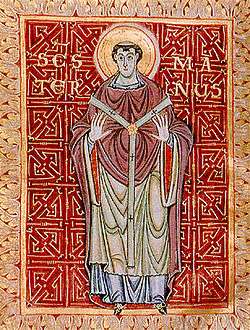Maternus of Cologne
Maternus (c. 285–September 14, 315), also known as Maternus II, was a Roman-Catholic saint, allegedly the third bishop of Trier, the first known bishop of Cologne, and founder of the diocese of Tongeren.
- Saint Maternus of Milan was bishop of Milan.
Saint Maternus | |
|---|---|
 | |
| Born | c. 285 |
| Died | September 14, 315 |
| Venerated in | Roman Catholic Church Eastern Orthodox Church |
| Feast | September 14 |
Life
According to Eusebius, the real Bishop Maternus was active during the period of the Donatist controversy. In May 313, Maternus and other bishops were summoned to Rome by Emperor Constantine to consult regarding the status of Bishop Caecilianus of Carthage. He also took part in the Synod of Arles in 314.[1] While a legend grew in Trier concerning Maternus, a popular cult developed in Cologne.[2]
The Bollandists and others date his Episcopate to the fourth century. He was the first Apostle of Alsace, and successfully promoted the spread of Christianity in that Province and in Western Germany.[3]
Legend
According to legend, he was a follower of Saint Eucharius, the first bishop of Trier. Eucharius was sent to Gaul by Saint Peter as bishop, together with the deacon Valerius and the subdeacon Maternus, to preach the Gospel. They came to the Rhine and to Ellelum in Alsace, where Maternus died. His two companions hastened back to St. Peter and begged him to restore the dead man to life. St. Peter gave his pastoral staff to Eucharius, and, upon being touched with it, Maternus, who had been in his grave for forty days, returned to life. The Gentiles were then converted in large numbers. After founding many churches the three companions went to Trier where the work of evangelization progressed so rapidly that Eucharius chose that city for his episcopal residence. [4]
Maternus assisted Valerius for fifteen years and then succeeded him as bishop of Trier for the next forty years. While assisting Valerius, he had already founded the dioceses of Cologne and Tongeren. He also founded a church on the site of a Roman temple which later became Cologne Cathedral. The staff of Saint Peter, with which he had been raised to life, was preserved in Cologne till the end of the tenth century when the upper half was presented to Trier, and was afterwards taken to Prague by Emperor Charles IV.[4]
The legend is from the ninth century and appears to have been intended to attest to the ancient establishment of the see of Trier, and therefore seniority over other dioceses in Germany.[2]
References
- "St. Maternus, Bishop of Cologne", Kolner Dom
- Agasso, Domenico. "Saint Maternus of Cologne", Santi e Beati, September 3, 2001
- Monks of Ramsgate. “Maternus”. Book of Saints, 1921. CatholicSaints.Info. 7 December 2014
- Meier, Gabriel. "St. Eucharius." The Catholic Encyclopedia Vol. 5. New York: Robert Appleton Company, 1909. 10 February 2019
![]()
| Wikimedia Commons has media related to Maternus of Cologne. |
| Titles of the Great Christian Church | ||
|---|---|---|
| Preceded by Valerius |
Archbishop of Trier 300 – 327 |
Succeeded by Agricius |